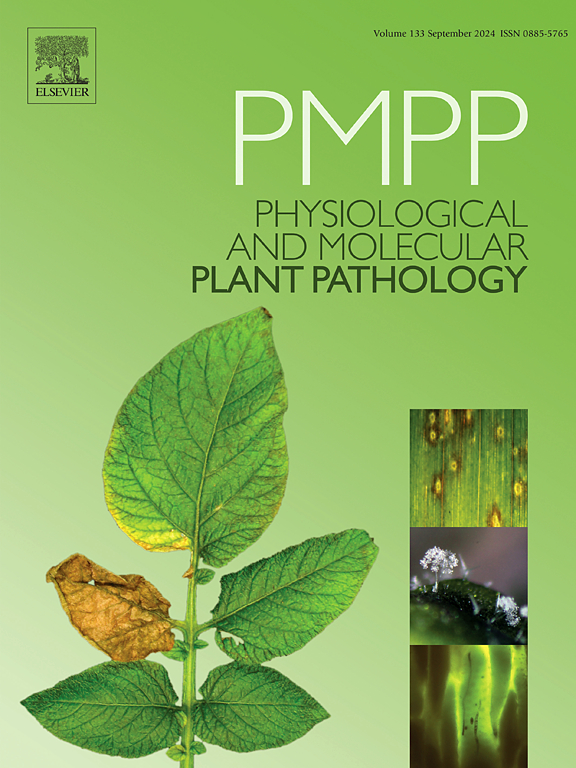Discovery of novel pathogens causing black spots on Torreya grandis cv. Merrillii nut and fungicide effectiveness during post-ripening
IF 2.8
3区 农林科学
Q2 PLANT SCIENCES
引用次数: 0
Abstract
Torreya grandis, a highly nutritious nut endemic to South China, undergoes a critical postharvest stage for nutrient conversion, aroma synthesis, and removal of astringency. Black spots disease is a common and serious post-harvest disease that severely affects nut quality, with black spots appearing on the hard shell and internal seed coat, accompanied by a peculiar odour. In this study, pathogens mediating for infection were annotated alongside profiling of volatiles via gas chromatography-mass spectroscopy (GC-MS) in the infected nuts. Additionally, the effectiveness of tetramycin against black spots disease was evaluated. Lasiodiplodia theobromae TGBHS1 was identified as the primary causal pathogen for black spots using morphological and molecular phylogenetic analysis. Furthermore, the aroma compounds of TGBHS1 infected nuts notably increased compared to the control group, including alcohols, aldehydes, esters, and ketones, especially with the unpleasant smell compounds terpinen-4-ol and Bicyclo [3.1.1]hept-3-en-2-one, 4,6,6-trimethyl-, (1S). Optimal conditions for mycelial growth of TGBHS1 were at 30 °C and pH 5.0, with sucrose serving as the preferred carbon source. Among the tested concentrations of tetramycin, 3.0 × 10−3 g L−1 was found to be highly effective in mitigating black spots incidence prior to the postharvest stage. Such findings offer brand-new understanding on pathogen management and postharvest optimization in T. grandis nut leading to improved quality and safety.
大香榧黑斑病病原菌的发现。榛果成熟后的杀菌剂效果
大香榧是华南特有的一种营养丰富的坚果,它在采后经历了营养转化、香气合成和涩味去除的关键阶段。黑斑病是一种常见的严重的收获后病害,严重影响坚果品质,硬壳和内种皮上出现黑点,并伴有异味。在这项研究中,通过气相色谱-质谱(GC-MS)分析了感染坚果的挥发物,并对介导感染的病原体进行了注释。此外,还评价了土霉素对黑斑病的防治效果。通过形态学和分子系统发育分析,鉴定出可可激光双plodia TGBHS1为黑斑病的主要致病病原体。此外,与对照组相比,TGBHS1感染坚果的香气化合物显著增加,包括醇类、醛类、酯类和酮类,尤其是气味难闻的化合物terpinen-4-ol和Bicyclo[3.1.1]庚-3-en-2- 1,4,6,6 -三甲基-,(1S)。TGBHS1菌丝生长的最佳条件为30℃,pH 5.0,蔗糖为首选碳源。在试验浓度中,发现3.0 × 10−3 g L−1对减少采后阶段黑斑的发生率非常有效。这些研究结果为核桃病原菌管理和采后优化提供了全新的认识,从而提高了核桃的品质和安全性。
本文章由计算机程序翻译,如有差异,请以英文原文为准。
求助全文
约1分钟内获得全文
求助全文
来源期刊
CiteScore
4.30
自引率
7.40%
发文量
130
审稿时长
38 days
期刊介绍:
Physiological and Molecular Plant Pathology provides an International forum for original research papers, reviews, and commentaries on all aspects of the molecular biology, biochemistry, physiology, histology and cytology, genetics and evolution of plant-microbe interactions.
Papers on all kinds of infective pathogen, including viruses, prokaryotes, fungi, and nematodes, as well as mutualistic organisms such as Rhizobium and mycorrhyzal fungi, are acceptable as long as they have a bearing on the interaction between pathogen and plant.

 求助内容:
求助内容: 应助结果提醒方式:
应助结果提醒方式:


